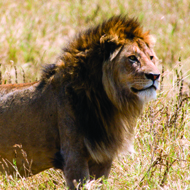Lion trophy hunting 'could aid conservation'

Lions have disappeared from over 90 per cent of their range and are now fewer in number than rhinos.
Trophy hunting has the potential to contribute to lion conservation, if it is well-regulated, transparent and delegates enough authority to land managers. This is the conclusion of a report for the UK government, led by Oxford University's Professor David Macdonald, who had been studying Cecil the lion before he was unlawfully killed by a US dentist in July last year.
Prof Macdonald was invited to conduct the review earlier this year by Rory Stewart, then under secretary of state for the environment. It suggests how the government could enhance lion conservation and identify criteria for considering applications to import lion trophies into the UK.
According to the report, the most fundamental conservation benefit of lion trophy hunting is that it provides a financial incentive to maintain lion habitat that may otherwise be put to non-wildlife uses. Estimates suggest trophy hunting areas in Africa cover 1.4 million km2, 22 per cent more land than national parks.
However, in many countries, poor governance and weak regulations can lead to unsustainable trophy hunting. Trophy hunting of lions is practised on a significant level in at least 12 countries and this has a negative impact on some populations, especially when poorly managed and compounded by other threats.
The UK imports up to three lion trophies each year and the report lays out criteria for considering applications. Prof Macdonald and the team recommend that the government should only accept imports where the hunting of the lion is unlikely to have had a detrimental effect on the population from which it was taken; and has contributed to lion conservation.
Lions have disappeared from over 90 per cent of their range and are now fewer in number than rhinos. The primary threats, which vary by region, are habitat loss and degradation, loss of prey base and conflict with humans over livestock. These threats are likely to get worse as a result of climate change and the rising human population, researchers note.
A press release on the report stressed that the core team who compiled the report did so from a position of professional neutrality - neither pro or anti-hunting, but in favour of good evidence and against the bad management of lion populations. They said the government will also need to invest heavily in tackling the issues beyond trophy hunting.



 The BSAVA has opened submissions for the BSAVA Clinical Research Abstracts 2026.
The BSAVA has opened submissions for the BSAVA Clinical Research Abstracts 2026.